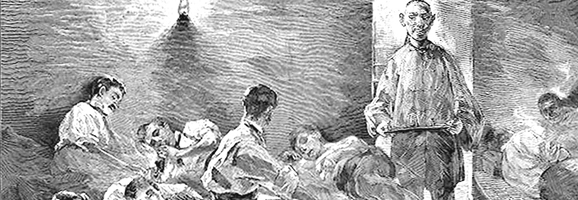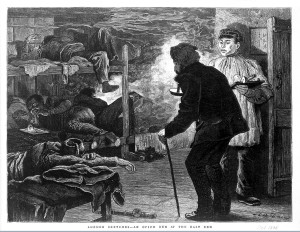
The area around Limehouse has long been associated with the original London ‘Chinatown’- and with it, the first and much exaggerated home of the East End opium dens. Limehouse was an established slum in the middle of the nineteenth century, and with its narrow buildings and foggy streets, it had a reputation for its sordid pubs, brothels, and opium dens. To an East Londoner or a visiting sailor, it was foreign enough for them to be able throw off the rigid manners of Victorian Britain.
In the East End, opium dens were usually associated with the Chinese, because it was invariably the Chinese who supplied the opium in the first place, as well as preparing it for visiting non-Chinese smokers. Chinese seamen who found themselves stranded in London were allowed to work in the East London docks with a large number involved in unloading China tea.
Originally, many of these Chinese sailors found lodgings at the ‘Oriental Quarters’ alongside the River Thames at Shadwell (very close to the present day location of Wapping Underground Station). These ‘Oriental Quarters’ were frequently run by English women who were able to speak Oriental languages, and who often went by names such as ‘Canton Kitty’ or ‘Chinese Emma’. Of these, ‘Chinese Emma’ was well known for running a Chinese gambling house, where card games would be played in the rooms downstairs whilst the first floor served as an opium den.

An East End Opium Den
Most opium dens kept a supply of opium equipment, such as specialized pipes and lamps that were necessary to smoke the drug. The opium den customers would recline on beds and makeshift benches in order to hold the long opium pipes over oil lamps. In that way, the pipes would warm and that in turn would heat the drug until it vaporized, allowing the smoker to inhale the vapours.
However, it would appear that the reputation of Victorian London as a centre of opium smoking is rather unjustified and owes more to popular literary fiction of the time than actual historical fact.
The London press, along with popular British authors of the day, such as Arthur Conan Doyle and Charles Dickens succumbed to using London’s Limehouse district as a focal point for the opium-drenched exploits of their heroes and heroines. The books ‘The Man with the Twisted Lip’ and ‘The Picture of Dorian Gray’ both make reference to the opium dens in the East End, but there is little evidence to support the illusion that so many dens existed.
London’s Chinatown soon developed a reputation for opium-induced sordidness and debauchery – yet it would appear that the sole intent of this reputation was to titillate and shock British readers.
